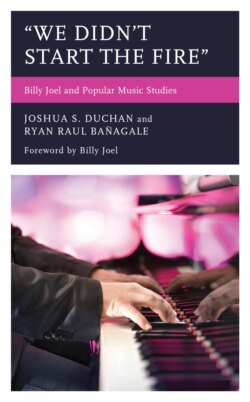Читать книгу “We Didn’t Start the Fire” - Группа авторов - Страница 12
На сайте Литреса книга снята с продажи.
NOTES
Оглавление1. An earlier conference, “Billy Joel and the Law,” was held at Touro Law School in 2015 and featured presentations that largely used Joel’s songs as a point of departure from which to examine legal issues. In contrast, the 2016 Billy Joel Conference examined the music itself for its musical, historical, and cultural value. Proceedings from the 2015 conference were published in the Touro Law Review 32, no. 1 (2015).
2. Jack Buehrer, “Academics Are Taking Piano Man Seriously,” The New York Times, October 11, 2016, C3.
3. See, for example, several posts on the subject on the American Musicology Society’s public-facing blog, “Musicology Now,” www.musicologynow.org/search?q=public+musicology.
4. An example of a textbook mentioning Joel only in passing is Michael Campbell, Popular Music in America: The Beat Goes On (Boston, MA: Cengage, 2018), in a text box noting that his music “ranges far beyond conventional rock” (333) and in a list of highly profitable touring acts in 2015 (377). In fact, when Joel is mentioned in scholarship, it is often a brief reference to him as a musical influence on others or as an example of “bad” music. Joel’s influence on others can be seen in Fred Maus, “Intimacy and Distance: On Stipe’s Queerness,” Journal of Popular Music Studies 18, no. 2 (2006): 191–214 and Elina Shatkin, “The Strange Case of Chris Gaines and Garth Brooks,” Journal of Popular Music Studies 25, no. 3 (2013): 389–397. Joel’s music as “bad” music is discussed in Leslie M. Meier, “In Excess? Body Genres, ‘Bad’ Music, and the Judgment of Audiences,” Journal of Popular Music Studies 20, no. 3 (2008): 240–260.
5. Walter Everett, “The Learned vs. The Vernacular in the Songs of Billy Joel,” Contemporary Music Review 18, no. 4 (2000): 105–129. A precursor to Everett’s work may be found in Christian Klein, “A Multi-Level Analysis of Billy Joel’s ‘Goodnight Saigon,’” Popular Music and Society 15, no. 3 (1991): 75–93, although Klein’s study engages less with the music, per se, and more with its reception. Michael Longrie’s article, “Billy Joel’s History Lesson,” College Teaching 45, no. 4 (1997): 147–149, also predates Everett’s but focuses almost entirely on lyrics rather than musical content.
6. See, for instance, Scott Allsop, “‘We Didn’t Start the Fire’: Using 1980s Popular Music to Explore Historical Significance by Stealth,” Teaching History 137 (2009): 52–59. Later examples include Michael Borshuck, “The ‘Professional’ Singer-Songwriter in the 1970s,” in The Cambridge Companion to The Singer-Songwriter, ed. Katherine Williams and Justin Williams (New York: Cambridge University Press, 2016), 86–99; Joshua S. Duchan, “Disappointment, Frustration, and Resignation in Billy Joel’s The Nylon Curtain,” Rock Music Studies 2, no. 2 (2015): 168–187; A. Morgan Jones, “The Other Sides of Billy Joel: Six Case Studies Revealing the Sociologist, the Balladeer, and the Historian” (Ph.D. diss, University of Western Ontario, 2011); and Sean Atkinson, “Deceptive Love and Denied Endings: Tropes in the Music of Billy Joel,” Popular Music 37, no. 3 (2018): 415–423.
7. See, for example, Ken Bielen, The Words and Music of Billy Joel (Santa Barbara, CA: Praeger, 2011), Thomas MacFarlane, Experiencing Billy Joel: A Listener’s Companion (Lanham, MD: Rowman & Littlefield, 2016), and Joshua S. Duchan, Billy Joel: America’s Piano Man (Lanham, MD: Rowman & Littlefield, 2017).
8. Joshua S. Duchan, “From ‘New York State of Mind’ to ‘No Man’s Land’: Billy Joel’s Songs about American Places,” American Music Research Center Journal 24 (2015): 37–54.
9. The transcript has been “lightly” edited for clarity, including notes on the sources of the songs mentioned during the conversation.
10. Nate Agarwal, Caleb Cofsky, Jordan Rudman, Jonathan Sabetta, Naomi Sherman, and Jessica Wright, Envisioning the Piano Man: A Collective Experience of Billy Joel, exhibit guide.
11. Photographer Kevin Mocker graciously contributed multiple images that he had taken at concerts over the course of Billy Joel’s career. Jim Bosse, a lifelong friend of Joel’s and subject of the song “James,” provided images of Joel performing with their high school band, The Lost Souls.
12. Envisioning the Piano Man, exhibit guide.
13. See Duchan, Billy Joel, xi–xxii for a timeline of Joel’s life and career, and 1–14 for a biography. A more detailed and complete biography is Fred Schruers, Billy Joel: The Definitive Biography (New York: Crown Archetype, 2014).
14. Duchan, Billy Joel, 7–8.
15. See chapter 1 for a detailed discussion of the Beatles’ influence on several tracks from this album.
16. There are two exceptions: Joel released two individual records in the popular style, “All My Life” and “Christmas in Fallujah,” in 2007.
17. See chapter 11 for a detailed discussion of Joel’s compilations and box sets.
18. One example is Hector Berlioz’s program accompanying his Symphonie Fantastique (1830), which is considered in detail in Nicholas Temperly, “The Symphonie Fantastique and Its Program,” The Musical Quarterly 57, no. 4 (1971): 593–608. Indeed, composers’ letters (such as those of Wolfgang Amadeus Mozart and Ludwig van Beethoven) often feature in musicological studies of their works, contributing to our understanding of them. In the case of Joel’s music, a similar trend is evident, as quotes from interviews are used, in both scholarship (e.g. Duchan, Billy Joel) and in mass-market biographies (e.g., Schruers, Billy Joel), to analyze and discuss his songs.
